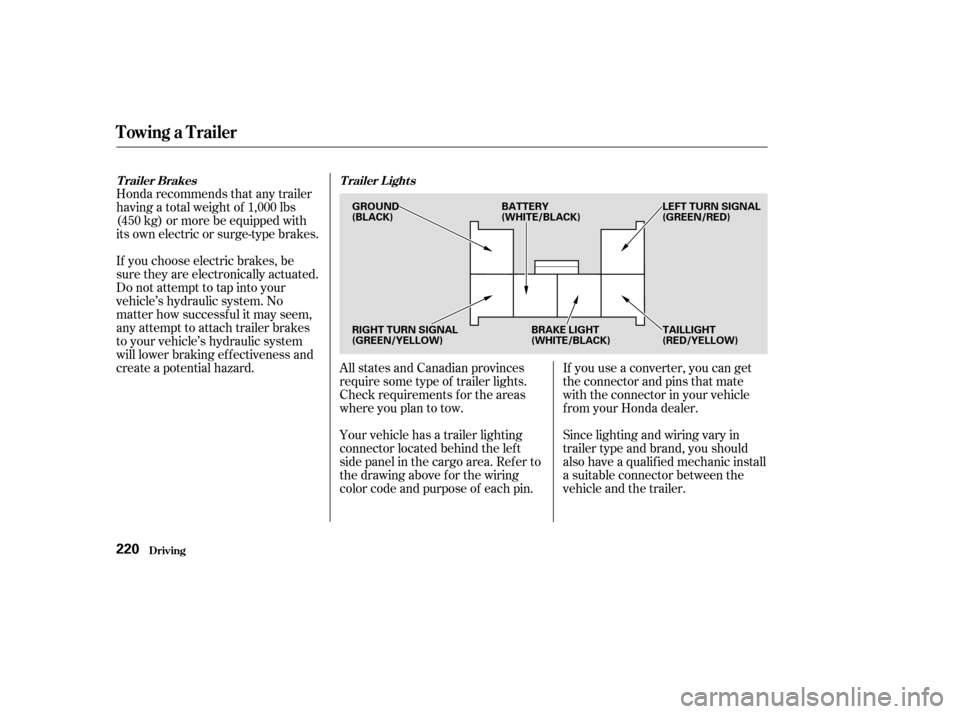2003 HONDA CR-V brake
[x] Cancel search: brakePage 224 of 374

Honda recommends that any trailer
having a total weight of 1,000 lbs
(450 kg) or more be equipped with
its own electric or surge-type brakes.
If you choose electric brakes, be
sure they are electronically actuated.
Do not attempt to tap into your
vehicle’s hydraulic system. No
matter how successf ul it may seem,
any attempt to attach trailer brakes
to your vehicle’s hydraulic system
will lower braking ef f ectiveness and
create a potential hazard.Your vehicle has a trailer lighting
connector located behind the lef t
side panel in the cargo area. Ref er to
thedrawingaboveforthewiring
color code and purpose of each pin. All states and Canadian provinces
require some type of trailer lights.
Check requirements f or the areas
where you plan to tow.If you use a converter, you can get
the connector and pins that mate
with the connector in your vehicle
f rom your Honda dealer.
Since lighting and wiring vary in
trailer type and brand, you should
also have a qualif ied mechanic install
a suitable connector between the
vehicle and the trailer.
Trailer Brakes
Trailer Lights
Towing a Trailer
Driving220
GROUND
(BLACK) LEFT TURN SIGNAL
(GREEN/RED)
RIGHT TURN SIGNAL
(GREEN/YELLOW) BRAKE LIGHT
(WHITE/BLACK)TAILLIGHT
(RED/YELLOW)
BATTERY
(WHITE/BLACK)
Page 225 of 374

Many states and Canadian provinces
require special outside mirrors when
towing a trailer. Even if they don’t,
you should install special mirrors if
you cannot clearly see behind you, or
if the trailer creates a blind spot.
Askyourtrailersalesorrental
agency if any other items are
recommended or required f or your
towing situation.When preparing to tow, and bef ore
driving away, be sure to check the
f ollowing:
The vehicle has been properly
serviced, and the tires, brakes,
suspension, and cooling system
are in good operating condition. The lights and brakes on your
vehicle and the trailer are working
properly.
The trailer has been properly
serviced and is in good condition.
Allitemsonandinthetrailerare
properly secured and cannot shif t
while you drive. Thehitch,safetychains,andany
other attachments are secure. Your vehicle tires and spare are
properly inf lated (see page ),
and the trailer tires and spare are
inflated as recommended by the
trailer maker.
All weights and loads are within
limits (see pages and ). If you tow f requently, f ollow the
Severe Conditions maintenance
schedule. 217 218 278
Additional Trailer EquipmentPre-T ow Checklist
Towing a Trailer
Driving221
Page 226 of 374

The added weight, length, and
height of a trailer will af f ect your
vehicle’s handling and perf ormance,
so driving with a trailer requires
some special driving skills and
techniques.
Foryoursafetyandthesafetyof
others,taketimetopracticedriving
maneuvers bef ore heading f or the
open road, and f ollow the guidelines
discussed below.If the automatic transmission shif ts
f requently between 3rd and 4th
gears while going up a hill, turn of f
the Over drive (O/D) mode (see
page ). When climbing hills, closely watch
your temperature gauge. If it nears
the red mark, turn the air
conditioning of f , reduce speed and, if
necessary, pull to the side of the
road to let the engine cool.
Make turns more slowly and wider
than normal. The trailer tracks a
smaller arc than your vehicle, and it
canhitorrunoversomethingthe
vehicle misses. Allow more time and
distance f or braking. Do not brake or
turn suddenly as this could cause the
trailer to jackknif e or turn over. Drive slower than normal in all
driving situations, and obey posted
speed limits f or vehicles with trailers.
If you have an automatic
transmission, use the Over drive
(O/D) mode when towing a trailer
on level roads. Turn of f the Over
drive (O/D) mode when towing a
trailer in hilly terrain (see page ).
(See ‘‘ ’’ in the next
column f or additional gear
inf ormation.)
If youmuststopwhenfacinguphill,
use the f oot brake or parking brake.
Do not try to hold the vehicle in
placebypressingontheaccelerator,
as this can cause the automatic
transmission to overheat.
207
207
Driving Saf ely With a T railer
Towing a Trailer
Driving
Driving on Hills
Making T urns and Braking Driving on Hills
T owing Speeds and Gears
222
Page 227 of 374

Follow all normal precautions when
parking, including f irmly setting the
parking brake and putting the
transmission in Park (automatic) or
in 1st or Reverse (manual). Also,
place wheel chocks at each of the
trailer’s tires. Always drive slowly and have
someone guide you when backing up.
Grip the of the steering
wheel; then turn the wheel to the lef t
to get the trailer to move to the lef t,
andturnthewheelrighttomovethe
trailer to the right.
When driving down hills, reduce
your speed and shif t down to 3rd
gear on the manual transmission,
and turn off the Over drive (O/D)
mode on the automatic transmission.
Do not ‘‘ride’’ the brakes, and
remember it will take longer to slow
downandstopwhentowingatrailer.
Crosswinds and air turbulence
caused by passing trucks can disrupt
your steering and cause trailer
swaying. When being passed by a
large vehicle, keep a constant speed
and steer straight ahead. Do not try
to make quick steering or braking
corrections.
bottom
Parking
Backing Up
Handling Crosswinds and Buf f et ing
Driving
Towing a Trailer
223
Page 228 of 374

When preparing to tow your CR-V,
make sure the transmission is
f illed to the correct level (see page). Do not overf ill.
Leave the key in the ignition
switch and the ignition switch in
ACCESSORY (I) so the steering
wheel does not lock. Make sure
the radio and any items plugged
into the accessory power sockets
are turned of f so you do not run
down the battery. Shif t the transmission to Neutral. Release the parking brake.
After attaching the tow bar to your
motorhome, do the following to
prepare your CR-V f or ‘‘f lat towing’’: When purchasing a tow bar, make
sure you select a reputable
manuf acturer and installer. Follow
the manufacturer’s attachment
instructions caref ully. Your CR-V can be towed behind a
motorhome at legal highway speeds
up to 65 mph(100 km/h). Do not
exceed 65 mph(100km/h).
Otherwise, severe transmission
damage will occur. To avoid damage
to the 4WD system, it must be towed
with all f our wheels on the ground
(f lat towing). When preparing to tow your CR-V,
make sure the transmission is f ull of
fluid (see page ). Maintaining
the correct level is very important.
Do not overf ill. Do the f ollowing
Follow the procedure exactly.
Otherwise, severe automatic
transmission damage will occur.
261
260
every day immediately bef ore you begin
towing.
5-speed Manual T ransmission A ut omat ic T ransmission
Towing Your Vehicle Behind a Motorhome
Driving224
Page 229 of 374

Start the engine.
Press on the brake pedal. Shif t the
lever through all the positions (P,
R, N, D, 2, 1)
ShifttoD,thentoN.Letthe
engine run f or three minutes, then
turn of f the engine.
Release the parking brake.
Leave the ignition switch in
ACCESSORY (I) so the steering
wheel does not lock. Make sure
the radio and any items plugged
into the accessory power sockets
are turned of f so you do not run
down the battery.If you tow more than 8 hours in one
day, you should repeat the above
procedure at least every 8 hours.
(when you stop f or f uel, etc.)
If youtowaCR-Vwithanautomatic
transmission, the transmission f luid
must be changed every two years or
30,000 miles (48,000 km), whichever
comes f irst.Ext ended T owing
Towing Your Vehicle Behind a Motorhome
Driving225
Failure to f ollow the above instructions
exactly will result in severe automatic
transmission damage. If you cannot
shif t the transmission or start the
engine, your vehicle must be
transported on a f lat-bed truck or
trailer. The steering system can be damaged if
the steering wheel is locked. Leave the
ignition switch in Accessory (I), and
make sure the steering wheel turns
f reely bef ore you begin towing.Severe automatic transmission damage
will occur if the vehicle is shif ted f rom
reverse to neutral and then towed with
the drive wheels on the ground.
Page 232 of 374

After you return to the pavement,
caref ully inspect your vehicle to
make sure there is no damage that
could make driving it unsaf e. Check
the tires for damage and for proper
pressure. Driving of f -highway can be hard on a
vehicle. Bef ore you leave the
pavement, be sure all scheduled
maintenance and service has been
done, and that you have inspected
your vehicle. Pay special attention to
the condition of the tires, and use a
gauge to check the tire pressures. The f ollowing pages contain practical
tips on basic of f -highway operation.Of f -highway, the general rule is to
keep your speed low. Of course,
you’ll need enough speed to keep
moving forward. But at higher
speeds, you have less time to assess
conditions and make good decisions.
There’s also a greater chance of
sliding if you brake or turn too
quickly on wet soil, gravel, or ice. In
any situation, never go f aster than
conditions allow.
Forbettertractiononallsurfaces,
accelerate slowly and gradually build
up speed. If you try to start too fast
on wet soil, mud, snow, or ice, you
might not have enough traction to
get underway. You may even dig
yourself into a hole. Starting with the
shif t lever in second gear (2) will
help get you to a smooth start on
snow and ice.Generally, the best of f -pavement
braking technique is to gently
depress the brake pedal, then
increase pressure as more braking is
needed. Avoid hard braking. Keep in
mind that you will usually need more
time and distance to brake to a stop
on unpaved surf aces.
If you need to brake hard because of
an emergency, apply steady, even
pressure to the brake pedal. Do not
pump the brakes; let the anti-lock
braking system pump them f or you.
If you pump the brakes, the anti-lock
cannot work as ef f iciently, and your
stopping distance may be increased.
With ABS
Driving T ips
Check Out Your Vehicle
Cont rolling Speed
A ccelerat ing and Braking
Off-Highway Guidelines
Driving228
Page 233 of 374

Bumps, holes, rocks, and other
obstacles can be hazardous. Debris
in the road can damage your
suspension or other components.
Even small rocks can cut your tires.
More important, because your
vehicle has a high center of gravity,
driving over a large obstacle, or
allowing a wheel to drop into a deep
hole, can cause your vehicle to tip or
roll over.
Drive slow enough to observe
obstacles ahead and maneuver
around them. If you can’t avoid a
serious obstacle, turn around and
look f or a better route.
Bef ore driving up or down a hill, stop
and assess the situation. If you can’t
clearly see all road conditions (good
traction, no bumps, holes or other
obstacles, a safe way out, etc.) walk
the slope bef ore you drive on it. If
you have any doubt about whether
you can saf ely drive on the slope,
. Find another route.
If you are driving up a hill and f ind
that you cannot continue (because of
the steepness, a large obstacle, etc.), . Your vehicle
could roll over. Slowly back down the
hill, f ollowing the same route you
took up the hill.
You should have no problem making
sharp turns at low speed on level
ground. But never make an abrupt
turn at higher speeds, on or of f
pavement. With a higher center of
gravity, your vehicle can more easily
tip or roll over. Off-highway, the basic turning
technique is to drive at low speed
and gradually adjust the amount of
steering to suit the surf ace. Test your brakes from time to time
to make sure they are operating
properly. This will also give you a
f eel f or how much traction you have
on a given surf ace.
don’t do it
do not try to turn around
Avoiding Obstacles
Driving on Slopes
Off-Highway Guidelines
Driving
T urning
229